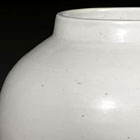J.J. Lally & Co., Oriental Art / New York City, New York
MenuPast Exhibition
Chinese Ceramics in Black and White
March 20–April 10, 2010
34.
A LARGE EARLY MING ‘SWEET WHITE’-GLAZED PORCELAIN JAR (GUAN)
Yongle Period (A.D. 1403–1424)
of heavily potted upright ovoid form, standing on a solid base, the high shoulders rounded up to a gently sloping short plain neck and wide circular mouth, the rimless foot encircled by a plain raised band echoing the neck, the sides showing faint irregular horizontal ribs from the potting and covered all over with a glossy translucent ‘tian bai’ white glaze shading to pale greenish-blue, especially where it gathers thicker around the rim, showing some pale tan-yellow areas on the interior where the glaze thins to allow the iron-rich porcelain to burn through, the slightly concave base left unglazed and the exposed white porcelain showing a tan brown color with many scattered dark brown spots of iron-rust interspersed with kiln grit, with a Qing dynasty hardwood cover mounted with a jade ruyi-form finial.
Height 133⁄8 inches (34 cm)
Compare the early Ming ‘sweet white’-glazed jar of similar size with lotus-leaf shaped porcelain cover in the collection of the Nanjing Museum, illustrated by Xu Huping in the catalogue The Treasures of the Nanjing Museum, Hong Kong, 2001, p. 56, no. 39.
A smaller guan of closely related form, with dragons lightly engraved under a ‘sweet white’ (tian bai) glaze, excavated from the site of the Ming imperial kilns at Jingdezhen, and dated to the Yongle period by archaeologists, is illustrated in Yuan and Ming Imperial Porcelains Unearthed from Jingdezhen, Beijing, 1999, p. 146, no. 95.
Geng Baochang includes a line drawing of a covered jar of this form in his illustrations of typical Yongle porcelain vessel shapes published in the research volume Ming Qing ciqi jianding (Authenticating Ming and Qing Porcelains), Hong Kong, 1993, p. 27, ill. 44.
明永樂 甜白釉大瓷罐 高 34 厘米
